
Books by Elizabeth MacLeod.
Elizabeth MacLeod
Profile by Dave Jenkinson.
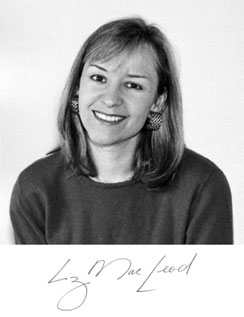 As I found in visiting the Toronto home of Elizabeth "Liz" MacLeod, there are certain benefits to interviewing authors who write books bearing titles such as Gifts to Make and Eat, Bake It and Build It, Bake and Make Amazing Cakes, and the book that found its tangible tasty expression during my visit, Bake and Make Amazing Cookies.
As I found in visiting the Toronto home of Elizabeth "Liz" MacLeod, there are certain benefits to interviewing authors who write books bearing titles such as Gifts to Make and Eat, Bake It and Build It, Bake and Make Amazing Cakes, and the book that found its tangible tasty expression during my visit, Bake and Make Amazing Cookies.
That Liz includes books about cooking among the types of books she authors should not be surprising given how she was raised. "As I grew up, I was encouraged by my mom to be in the kitchen and to be making things. I've always been interested in cooking and especially in baking. I think part of my interest is based on the fact that you take raw ingredients and make something that you can share with people and make them happy."
Liz, the youngest of three children and the only girl, was born in Thornhill, ON, just north of Toronto. She says that "I lived in Thornhill until I went off to university at the University of Toronto. As a child, I certainly never thought about being a writer. In those days, writers never came to our schools to talk to us, and I never thought about who wrote the books that we were reading."
"At university, I mainly studied Sciences because I thought English courses were too easy — talk about the confidence and ignorance of youth! I enjoyed science, but I came out of university not knowing what I was going to do. I backpacked through Europe for almost a year, and then, thanks to my science degree, got a job at the Ontario Ministry of the Environment."
"Shortly afterwards, I got a call from Yuri Rubinsky, who was a friend of my brother Douglas. Yuri was the Founding Co-Director of the Banff Publishing Workshop, and he called me on a Friday and said, 'I have a spot in the workshop. It starts Monday, and you're coming.' So I went!"
"I met wonderful people there, including Lynne Cunningham, Ian Brown, and Wayne Lawson, who was an editor at Vanity Fair. What I didn't realize was that they were looking for the next generation of magazine staff. After I returned home, Lynne called me to say that a job had come open at OWL Magazine. I applied, got the job and began working under Sylvia Funston, who was quite a mentor to me."
"When I was at OWL, I didn't make very much money — that's typical of magazine publishing — and so when somebody approached me to write some books for Grolier, I jumped at the chance. I needed the money, and the work also gave me some book-writing experience. Shortly after, I began working on the first three books in the 'Green World' series for the book-publishing arm of OWL."
 "I left OWL to work for a software company, SoftQuad, that was run by Yuri. The people at SoftQuad were all great, but I found the software world very different from children's publishing. While I was at SoftQuad, Val Wyatt, an editor with Kids Can Press, approached me about writing for the company. Val, in addition to being a terrific editor, writer and friend, was a real mentor to me. I began working on what ultimately became The Phone Book, a book about the telephone."
"I left OWL to work for a software company, SoftQuad, that was run by Yuri. The people at SoftQuad were all great, but I found the software world very different from children's publishing. While I was at SoftQuad, Val Wyatt, an editor with Kids Can Press, approached me about writing for the company. Val, in addition to being a terrific editor, writer and friend, was a real mentor to me. I began working on what ultimately became The Phone Book, a book about the telephone."
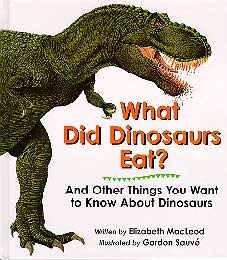 "A few months later, Kids Can hired me to edit for the company. I really enjoyed being back in the world of children's publishing full time. At that point, Kids Can had published no books about dinosaurs and we decided we should have one. We were throwing around ideas, trying to come up with a different take on the subject, when we came up with the idea of the 'extremes' of dinosaurs. Kids Can asked me to write the book, and so I put my book about the telephone on hold. The artwork in Dinosaurs: The Fastest, the Fiercest, the Most Amazing is spectacular. Seven years later, I returned to write about dinosaurs in What Did Dinosaurs Eat?"
"A few months later, Kids Can hired me to edit for the company. I really enjoyed being back in the world of children's publishing full time. At that point, Kids Can had published no books about dinosaurs and we decided we should have one. We were throwing around ideas, trying to come up with a different take on the subject, when we came up with the idea of the 'extremes' of dinosaurs. Kids Can asked me to write the book, and so I put my book about the telephone on hold. The artwork in Dinosaurs: The Fastest, the Fiercest, the Most Amazing is spectacular. Seven years later, I returned to write about dinosaurs in What Did Dinosaurs Eat?"
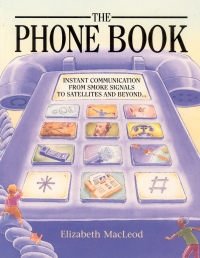 "I couldn't have written The Phone Book without my husband, Paul. He's an IT guy, a computer geek. He was incredibly helpful explaining so many things. I learned a lot while I was writing that book — not only about how the telephone works but also about all the amazing things Alexander Graham Bell invented or achieved."
"I couldn't have written The Phone Book without my husband, Paul. He's an IT guy, a computer geek. He was incredibly helpful explaining so many things. I learned a lot while I was writing that book — not only about how the telephone works but also about all the amazing things Alexander Graham Bell invented or achieved."
"Kids Can next asked me to write Get Started: Stamp Collecting for Canadian Kids because I used to write a newsletter for Canada Post that was called The Stamp Traveler. The book and newsletter made me realize how fascinating stamps are. They're inexpensive and easy-to-carry souvenirs if you're traveling to a lot of countries. And stamps are so beautiful — some of them are like little works of art. I loved writing the book and had fun researching the sorts of things that kids like to know, such as what's the biggest stamp ever, the smallest, the most valuable, etc. There's a story about a stamp that started a war, and another about how cats were once used to handle mail. That didn't last long!"
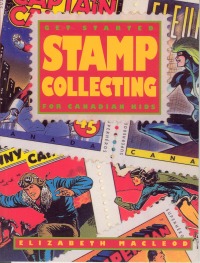 Two threads run through Liz's nonfiction titles, cooking/crafting books and biographies, but she has authored one picture book, I Heard a Little Baa. "That book came out of a discussion with Ricky Englander, the former co-publisher at Kids Can. We were talking about how much we liked rhyming books, and I said how much I also loved the 'What's It' puzzles that were on the back page of OWL. The puzzles showed very close-up photographs of everyday things. Ricky said, 'Well there's an idea. Rhymes and a puzzle. Go ahead and write it.'"
Two threads run through Liz's nonfiction titles, cooking/crafting books and biographies, but she has authored one picture book, I Heard a Little Baa. "That book came out of a discussion with Ricky Englander, the former co-publisher at Kids Can. We were talking about how much we liked rhyming books, and I said how much I also loved the 'What's It' puzzles that were on the back page of OWL. The puzzles showed very close-up photographs of everyday things. Ricky said, 'Well there's an idea. Rhymes and a puzzle. Go ahead and write it.'"
"As I was driving home that night, I suddenly started getting ideas for the book. I was frantic — 'How can I remember everything until I get home??' I had to keep repeating the rhymes to myself. There are only nine verses in I Heard a Little Baa, but I wrote 22 and let my editor, Debbie Rogosin, make the final choice. The book went on to be read on Mr. Roger's Neighborhood. What an honor! I was interested to see that Mr. Rogers didn't read the verses about the snake or the bee. I guess someone thought they would scare kids."
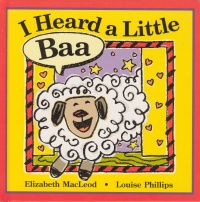 What was to become Liz's series of craft books in the "Kids Can Do It" series began because of another casual conversation at Kids Can. "I don't remember what we were talking about, but I said, 'You could make a cabin out of strips of Brownies,' and I went on, saying, 'You could create this from oatmeal cookie dough, and you build that from shortbread dough.' Someone turned to me and asked, 'Do you want to write a book on this?' And so, that's how my first cook book, Bake It and Build It originated."
What was to become Liz's series of craft books in the "Kids Can Do It" series began because of another casual conversation at Kids Can. "I don't remember what we were talking about, but I said, 'You could make a cabin out of strips of Brownies,' and I went on, saying, 'You could create this from oatmeal cookie dough, and you build that from shortbread dough.' Someone turned to me and asked, 'Do you want to write a book on this?' And so, that's how my first cook book, Bake It and Build It originated."
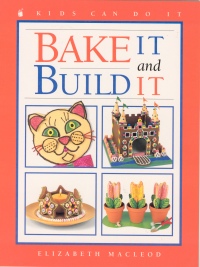 Grow It Again, a book about growing plants essentially from garbage, can trace some of its origins to a summer job. "I worked at the Science Center during the summers while I was at university. I actually helped develop the greenhouse collection there. Growing plants from plant parts and activities for kids were some of the things we were investigating then. I always thought growing plants from scraps that you'd usually throw out was a great idea. I was so happy to be able to gather together all of my ideas into a book. I organized my book by the different rooting or growing methods, and then I also had to come up with craft ideas, such as decorating suggestions and recipes. The groaner jokes are mine, too! I tested and grew all of the plants that are in the book, something I couldn't do now because we have cats who like to chomp on anything green."
Grow It Again, a book about growing plants essentially from garbage, can trace some of its origins to a summer job. "I worked at the Science Center during the summers while I was at university. I actually helped develop the greenhouse collection there. Growing plants from plant parts and activities for kids were some of the things we were investigating then. I always thought growing plants from scraps that you'd usually throw out was a great idea. I was so happy to be able to gather together all of my ideas into a book. I organized my book by the different rooting or growing methods, and then I also had to come up with craft ideas, such as decorating suggestions and recipes. The groaner jokes are mine, too! I tested and grew all of the plants that are in the book, something I couldn't do now because we have cats who like to chomp on anything green."
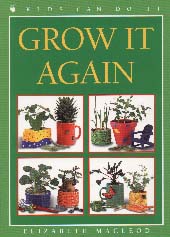 "Kids Can was pleased with Bake It and Build It, so the editor then asked me, 'What other ideas do you have, Liz?' So began Bake and Make Amazing Cakes. I wanted to come up with interesting cakes that kids could make and be pleased with the final result. You see a lot of decorated cakes that are impossible to make unless you're an artist. I wanted to create book of cakes that are fun to make and don't rely on a lot of artistic skill or equipment."
"Kids Can was pleased with Bake It and Build It, so the editor then asked me, 'What other ideas do you have, Liz?' So began Bake and Make Amazing Cakes. I wanted to come up with interesting cakes that kids could make and be pleased with the final result. You see a lot of decorated cakes that are impossible to make unless you're an artist. I wanted to create book of cakes that are fun to make and don't rely on a lot of artistic skill or equipment."
"The hamburger cake is one of my favorites. Kids Can also wanted a dinosaur cake in the book. The problem was giving the cake the necessary height but still making it stable. I solved that problem by including some toothpicks in the neck to hold the pieces together firmly. It took about three trial dinosaurs to get it right. The dino was sitting in my kitchen for at least a day because I wanted to make sure that, if kids made it ahead of time for a party, they wouldn't later find it in pieces on the plate."
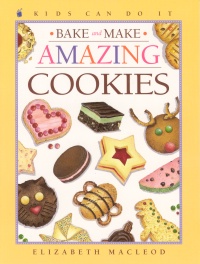 "The book's illustrator, June Bradford, made and decorated all of the cakes. Kids Can thought that it would be easier for her to do that instead of me. June was often having to illustrate a final stage in the construction, so the thinking was that that would be easier for her if she actually created the cakes as well. She did a great job!"
"The book's illustrator, June Bradford, made and decorated all of the cakes. Kids Can thought that it would be easier for her to do that instead of me. June was often having to illustrate a final stage in the construction, so the thinking was that that would be easier for her if she actually created the cakes as well. She did a great job!"
"The other fun things with books like this one is that I've been asked to appear on some TV and craft shows and make items from it. Most of the people working on these shows are very nice but not overly excited about yet-another guest — until they smell the baking! I was always popular when I left behind cakes for the staff to eat"
"Gifts to Make and Eat is one of my favorite books because it's such great combination of elements. There are recipes that kids can make, and they're all very easy. They cover a wide variety of different possibilities, everything from cookies to almond bark. In addition, there are all sorts of ideas for creating the packaging, including gift tags and more."
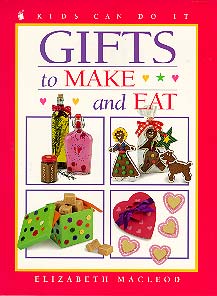 "I love making cookies, but when I was a kid, I always found it so frustrating to look at a cute cookie in a book but not be able to make it because I didn't have that specific cookie cutter. Consequently, in my book Bake and Make Amazing Cookies, there are very few cookies that call for cookie cutters. But there are all sorts of cookies that you can make that have interesting shapes."
"I love making cookies, but when I was a kid, I always found it so frustrating to look at a cute cookie in a book but not be able to make it because I didn't have that specific cookie cutter. Consequently, in my book Bake and Make Amazing Cookies, there are very few cookies that call for cookie cutters. But there are all sorts of cookies that you can make that have interesting shapes."
"For instance, there's a reindeer cookie that starts with just a circle of dough, so you can cut it out with a glass. You add broken pretzels for antlers, and Smarties for the nose and eyes. Another of my favorites is called Crazy Daisies. Each cookie starts as a ball of dough, that you cut into it with three equally spaced cuts that don't go all the way. When the ball bakes, it opens out like a daisy. The cookie is so easy to make and you get this great shape in the end."
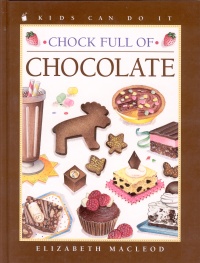 "Chock Full of Chocolate will be the last book in the cooking series, but I hope it's going to be popular because chocolate is such a favorite flavor. Again, I've got a real variety of recipes in the book, including the classics: chocolate fudge, chocolate cake and chocolate icing, chocolate chip cookies and more. I've included some fun recipes such as Polka-Dot Pie — a chocolate mixture that you blend together with colored miniature marshmallows. Silly Salami is a no-bake chocolatey roll chock full of chopped apricots and raisins. At the end of the book, I also give kids a whole bunch of quick recipes, so there's a lot packed into this book."
"Chock Full of Chocolate will be the last book in the cooking series, but I hope it's going to be popular because chocolate is such a favorite flavor. Again, I've got a real variety of recipes in the book, including the classics: chocolate fudge, chocolate cake and chocolate icing, chocolate chip cookies and more. I've included some fun recipes such as Polka-Dot Pie — a chocolate mixture that you blend together with colored miniature marshmallows. Silly Salami is a no-bake chocolatey roll chock full of chopped apricots and raisins. At the end of the book, I also give kids a whole bunch of quick recipes, so there's a lot packed into this book."
Liz has also authored the books in the "Snapshots" series of biographies. "It wasn't until I'd written a few of these books that Kids Can came up with a title for the series. One of the reasons we chose Snapshots is because every book is just 32 pages long so it gives kids a quick view of each person. Kids Can thought, 'Maybe if we title it Snapshots that'll get across the idea of something fast.' The name also says 'photography' and implies that these books are illustrated with photos rather than illustrations."
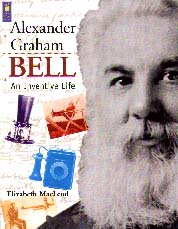 "Alexander Graham Bell was the subject of the first book because I had become so interested in him when I was researching The Phone Book. As well, I already knew there were fun and interesting stories about his childhood. Aleck was also an international figure who we hoped would have very strong Canadian sales because he's so associated with Canada."
"Alexander Graham Bell was the subject of the first book because I had become so interested in him when I was researching The Phone Book. As well, I already knew there were fun and interesting stories about his childhood. Aleck was also an international figure who we hoped would have very strong Canadian sales because he's so associated with Canada."
Then Kids Can said, 'We should publish a book about a woman next.' I felt Lucy Maud Montgomery was the obviously choice. Writing a book about Maud — she hated being called Lucy — was such a pleasure because I've always loved all of her books. The day I was assigned that book I went home thinking, 'Here's my excuse to read Anne of Green Gables again.' I read it that night, and, of course, I cried when I came to the part where Matthew dies. The next morning, I was looking for a quote I wanted from the book. I knew it was near the end of the book, so I read over again the section where Matthew dies, and I cried once more. Twice in just 12 hours! I thought, 'Wow, there's really something here if it can affect me like this every time.'"
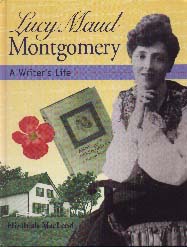 "The timing to write Lucy Maud Montgomery was perfect because the journals of her life had been published, and so I had easy access to primary sources about her. I didn't know until I began my research that she had spent so much of her life in Ontario. She actually lived in the west end of Toronto and in two other small towns outside of Toronto. I just loved writing about her. I got to re-read all of the Anne books and to find out where Maud got her inspiration. Kids are always fascinated to discover where writers' stories come from and what makes authors write what they do."
"The timing to write Lucy Maud Montgomery was perfect because the journals of her life had been published, and so I had easy access to primary sources about her. I didn't know until I began my research that she had spent so much of her life in Ontario. She actually lived in the west end of Toronto and in two other small towns outside of Toronto. I just loved writing about her. I got to re-read all of the Anne books and to find out where Maud got her inspiration. Kids are always fascinated to discover where writers' stories come from and what makes authors write what they do."
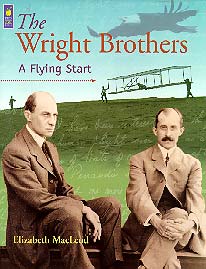 "The Wright Brothers was written because the hundredth anniversary of flight was coming up, and we wanted to have a book out about them. They were such obvious subjects, because everyone is interested in flight and the idea of overcoming gravity. Albert Einstein was also an obvious choice to write about in this series because he was named the most important person of the twentieth century by Time magazine."
"The Wright Brothers was written because the hundredth anniversary of flight was coming up, and we wanted to have a book out about them. They were such obvious subjects, because everyone is interested in flight and the idea of overcoming gravity. Albert Einstein was also an obvious choice to write about in this series because he was named the most important person of the twentieth century by Time magazine."
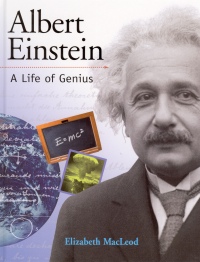 "I became very interested in Helen Keller, the subject of another book in the 'Snapshots' series, because of Alexander Graham Bell's connection to her. Helen and her parents met with Aleck and he put them in touch with the Perkins Institute for the Blind. That led Helen to Annie Sullivan, who was studying there, and as they say, the rest is history. I also think Helen's someone who interests kids because she had her big breakthrough of suddenly realizing what sign language actually meant when she was a child — she was only seven. Helen's accomplishments are overwhelming for anybody, but especially when you consider the handicaps that she had. I came to truly admire and enjoy her. In these 'Snapshots' books, I include quotes from the people because I like to give them a voice. Helen had so many great quotes. With some of the people, I have to work hard to find quotes that I think will mean something to children and will be interesting, but with Helen, she had so many that it was hard to pick what I could fit in the book."
"I became very interested in Helen Keller, the subject of another book in the 'Snapshots' series, because of Alexander Graham Bell's connection to her. Helen and her parents met with Aleck and he put them in touch with the Perkins Institute for the Blind. That led Helen to Annie Sullivan, who was studying there, and as they say, the rest is history. I also think Helen's someone who interests kids because she had her big breakthrough of suddenly realizing what sign language actually meant when she was a child — she was only seven. Helen's accomplishments are overwhelming for anybody, but especially when you consider the handicaps that she had. I came to truly admire and enjoy her. In these 'Snapshots' books, I include quotes from the people because I like to give them a voice. Helen had so many great quotes. With some of the people, I have to work hard to find quotes that I think will mean something to children and will be interesting, but with Helen, she had so many that it was hard to pick what I could fit in the book."
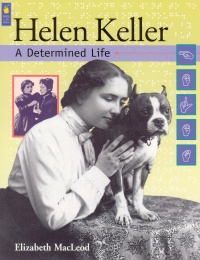 "You'll notice that we don't have a photograph of Helen's suitor, Peter Fagan. We could not find a photograph of him anywhere. I think that says that he was expunged. He had been warned off from Helen's house at gunpoint by the family. She had obviously arranged to elope with him, but I guess he got scared off. I have a sad image in my mind of Helen sitting in the dark waiting for her lover who will never come. Alexander Graham Bell had actually talked to her about the fact that a time would come when men would be interested in her, and I included the quote in my book: 'I can't imagine a man wanting to marry me. I should think it would seem like marrying a statue.'
"You'll notice that we don't have a photograph of Helen's suitor, Peter Fagan. We could not find a photograph of him anywhere. I think that says that he was expunged. He had been warned off from Helen's house at gunpoint by the family. She had obviously arranged to elope with him, but I guess he got scared off. I have a sad image in my mind of Helen sitting in the dark waiting for her lover who will never come. Alexander Graham Bell had actually talked to her about the fact that a time would come when men would be interested in her, and I included the quote in my book: 'I can't imagine a man wanting to marry me. I should think it would seem like marrying a statue.'
"Kids Can and I selected Marie Curie to be profiled in the series because she is the first woman of science. Marie was the first woman to win the Nobel Prize, the first woman to win it twice, and she and her daughter are the only mother-daughter ever to win Nobel Prizes. Marie grew up in Poland, but, when she fell in love with her husband, she realized she would have to leave behind her beloved Poland and live in France with him. That was very difficult for Marie. Her life also includes the very tragic love story of her husband's early death in an accident. They had quite a love affair, and I think neither of them expected to find that passion for anything but science. Pierre wooed Marie by giving her signed copies of his scientific reports — no flowers or chocolates for them!"
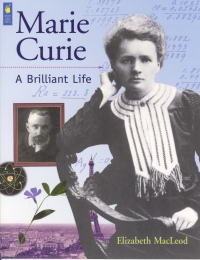 "A lot of interesting things happened to Marie when she was a university student. For instance, she had very little money and was freezing cold on winter nights, so she would pile everything on top of her, including her furniture. Soon after she discovered radioactivity, which was about one hundred years ago, people began putting radioactive materials in their makeup to give their faces a lovely glow. They added radiation to water to make it sparkle. When I'm out in schools talking to kids, I'll say to them, 'In another hundred years, what are people going to look back at and ask, "What were those people in 2005 thinking?"'"
The fall of 2005 saw the publication of Liz's book on Harry Houdini. "Harry is such an interesting person, not only because of his magic but because he was so good at promoting himself. One thing that made him challenging to write about was that he never told the same story twice about himself. For instance, for a long time, Harry claimed to be born in America because he thought that would make Americans like him better. Actually, he was born in Budapest and as a child came to Appleton, Wisconsin."
"A lot of interesting things happened to Marie when she was a university student. For instance, she had very little money and was freezing cold on winter nights, so she would pile everything on top of her, including her furniture. Soon after she discovered radioactivity, which was about one hundred years ago, people began putting radioactive materials in their makeup to give their faces a lovely glow. They added radiation to water to make it sparkle. When I'm out in schools talking to kids, I'll say to them, 'In another hundred years, what are people going to look back at and ask, "What were those people in 2005 thinking?"'"
The fall of 2005 saw the publication of Liz's book on Harry Houdini. "Harry is such an interesting person, not only because of his magic but because he was so good at promoting himself. One thing that made him challenging to write about was that he never told the same story twice about himself. For instance, for a long time, Harry claimed to be born in America because he thought that would make Americans like him better. Actually, he was born in Budapest and as a child came to Appleton, Wisconsin."
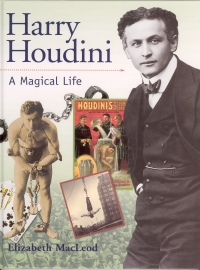 "Harry had a very difficult childhood. There was very, very little money, and he was always looking for a way to help his family get enough to eat. He and his brothers and sister were always cold because the family didn't have enough money for fuel. Of course at the height of his career, Harry was incredibly rich but he never forgot his beginnings."
"Harry had a very difficult childhood. There was very, very little money, and he was always looking for a way to help his family get enough to eat. He and his brothers and sister were always cold because the family didn't have enough money for fuel. Of course at the height of his career, Harry was incredibly rich but he never forgot his beginnings."
"I've just finished the first manuscript for a book about Eleanor Roosevelt. She was another fascinating woman. I had no idea how many different things she did. The main difficulty I had writing this book was cramming her into just 32 pages. Eleanor was born in the late 1800s, and so she was alive during the First World War, and of course her husband, Franklin, was President of the United States for the Second. She lived through the wars and the Great Depression. Eleanor lived until 1962 and still had incredible energy. She was active almost up to her death. And Eleanor had a great sense of humor. I found a quote by her that I couldn't put in my book, but I can paraphrase what she said: 'I was very honored to have a rose named after me until I read the description in the catalog of it. "Not good in a bed but fine up against a wall."'"
As Liz has noted, a major challenge in writing the "Snapshots" books is their brevity, just 32 pages. Despite, or perhaps because of, their short length, they still demand rigorous research. Explains Liz, "You obviously research far more information than is going to fit into 32 pages. Any nonfiction writer would say we're always looking for that story that's going to grab kids. We research and research, and think, 'Maybe if I look in one more book I'll find an amazing story.'"
"There have been times when I've sent in the first manuscript, and then I find that wonderful quote or a number of them, and I think, 'Are there ways I can work these in?' I can replace some of my quotes if I think the ones I've just found are better, but then you worry about what you have to leave out. I guess I go through that every time, but it seemed more extreme with Eleanor. For instance, I had to omit so many of the famous people with whom she worked or who were her friends, but they're people who don't mean anything to kids. I also had to concentrate on Eleanor, and not on FDR, except when his activities had an impact on her."
Interestingly, Liz has found Canadian connections for many of her American biographical subjects. "With Harry Houdini, I've always been fascinated by the story about how he was beaten up in Montreal. There's a question of whether or not a medium had hired this person to strike Harry because, at that point in his career, he was focusing on exposing fake mediums. The fellow said, 'Mr. Houdini, I understand that you can prepare yourself and take blows to the stomach.' Harry had never claimed that, but, before he could do anything, the fellow punched him hard several time. Harry died a few days later of a ruptured appendix."
"Another Canadian connection for Harry is that it was in an asylum in the Maritimes that he first saw an inmate in a straitjacket. That's when he got the idea for the straitjacket escape. Other 'Snapshots' connections? Eleanor Roosevelt took a holiday in Quebec and Eastern Canada and loved the Roosevelt cottage on Campobello Island in New Brunswick. One of the Wright Brothers, Wilbur, had a cottage in Georgian Bay for many years. This cottage was full of various inventions to make life easier, not surprising given that both brothers were inventors."
"One of the things that I love about the 'Snapshots' books is that they have a timeline at the end, and so I don't have to include dates in the main text for every little thing. I want to add in enough dates that kids know the period I'm talking about, but the timeline gives them the kind of information they need for projects. Consequently, I can tell more of a story and hopefully get across more of the person's personality because I think that's important."
"Kids Can's style is to have each spread standing on its own so that a child gets to see everything at once. The reader might be pulled into a spread by a photograph, an artifact or perhaps a quote. We hope the child will say, 'Oh, that's interesting,' and she'll then read the main text. Kids who aren't yet good readers might think there's a lot of text on a spread, so we provide ways of inviting them into the text and getting them interested in it. I like the fact that you don't have to turn a page. You get a full capsule view of a portion of the person's life, and then you're encouraged to go on. Organizing the material this way gives kids a chance to have a little break between the different spreads. That's nice because reading can be difficult, especially in nonfiction books that you're often reading for a project."
A challenge in finding subjects for the "Snapshots" series is identifying people for whom Kids Can Press can locate photographs that aren't too expensive. "Recently, I was talking to my editor and photo researcher, and we were bringing forward names to consider for future books. The photo researcher first has to look into answering the questions, 'Can we find enough photos, and are they in our price range?' Sometimes the photo-researcher will look into some of the images I'm hoping we can get and say, 'This photo you've suggested is too expensive for us, so how about this one?' Between the time I write the first manuscript and I write the second, I have a meeting with the editor, the photo-researcher and the designer. It's not until that point that we know exactly what photographs are going in each book."
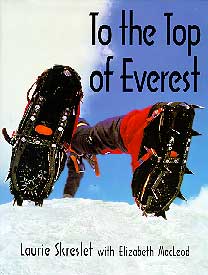 Another writing experience that Liz has had is that of being a co-author on a book about climbing Mount Everest. "To the Top of Everest came about because someone at Kids Can heard Laurie Skreslet, the first Canadian to climb Mount Everest, on the CBC radio show 'As It Happens.' Somebody said, 'We should get him to write a book for us.' I called him up as an editor and asked, 'Would you be interested?' He was, but it quickly became obvious that he's an active guy who can't sit at a desk for very long."
Another writing experience that Liz has had is that of being a co-author on a book about climbing Mount Everest. "To the Top of Everest came about because someone at Kids Can heard Laurie Skreslet, the first Canadian to climb Mount Everest, on the CBC radio show 'As It Happens.' Somebody said, 'We should get him to write a book for us.' I called him up as an editor and asked, 'Would you be interested?' He was, but it quickly became obvious that he's an active guy who can't sit at a desk for very long."
"Laurie had some ideas for authors, but for various reasons, they didn't work out. Finally, someone at Kids Can said, 'Liz, you try writing two of the spreads.' Kids Can was happy with what I wrote and so was Laurie. Laurie and I then sat down together a number of times, and I interviewed him on tape. Laurie has quite an inspirational and amazing story. What I found especially interesting is his statement that mountaineers don't talk about conquering Everest. They feel it's a privileged to be there — it's almost as if the mountain allows them climb it."
"It was an interesting experience to be a coauthor and not to have the final say as an author. I had to keep reminding myself that this was Laurie's story. For instance, he hated the word 'suddenly.' If you read the book, you'll find we don't use that word very often, if at all! Laurie also didn't like the words 'me' and 'I.' 'But Laurie,' I said to him. 'It's your story. Those words have to be there.' However, I came to understand that, when you work on something such as climbing Everest, you recognize how important teamwork is."
"As you read through the book, you see that it wasn't until close to the end that the decision was made, as a team, about who would go to the summit. Who was in the best shape to climb? Earlier in the expedition, Laurie had the bad luck to break some ribs, and he had to go back down the mountain. While Laurie was there, he got more oxygen into his blood and fresher food so that, when he came back, he was in better shape than many of the other climbers. They were all pushing to get somebody to the top, and the expedition members know that not everybody will have a chance to go. I think that must be very difficult — to be so close but know someone else is going to try for the summit."
"Something that was a little bit difficult for the book was that there are no photos of Laurie at the top because he used his camera to take photos of the guides. When the guides took photos of him, no one at the time knew that the camera was broken. That expedition also put Pat Morrow on the top of Everest so we do have photos of him on top of the world."
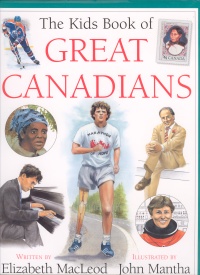 In 2004, Liz published The Kids Book of Great Canadians. "I guess I was an obvious choice to write this book since I'd already written so many biographies. But the biographies in this book are really short because there are so many amazing Canadians to try to fit into the book. There were so many people I had to leave out, which made me both sad and proud. Sad because they had such great stories, but proud because our country is full of such amazing people. This book made me so proud to be Canadian, which wasn't an outcome I was expecting.
In 2004, Liz published The Kids Book of Great Canadians. "I guess I was an obvious choice to write this book since I'd already written so many biographies. But the biographies in this book are really short because there are so many amazing Canadians to try to fit into the book. There were so many people I had to leave out, which made me both sad and proud. Sad because they had such great stories, but proud because our country is full of such amazing people. This book made me so proud to be Canadian, which wasn't an outcome I was expecting.
"In addition to the biography of Eleanor Roosevelt, the other book I'm presently working on is The Kids Book of Great Canadian Women. You may recall there were no women in the top 10 on the CBC poll and only 17 in the top 100. I knew from writing the first book that there are some amazing Canadian women and I really wanted to tell their stories. For instance, I was fascinated to read about Roberta Bondar. She actually turned down her first chance to go up in space because she felt she was being asked due to the fact that she was a woman, not because she was a scientist. There was nothing Roberta wanted to accomplish more than to go into space. So to turn down that opportunity must have been incredible for her. Roberta finally made it into space in 1992."
"Did you know that synchronized swimming was invented in Canada by a woman? Peg Seller came up with the rules and set up the first organized competition. Canada has gone on to be internationally famous in this sport, thanks to such women as Carolyn Waldo and Sylvia Frechette."
Deciding who would be included in the volume was a challenge. "The book is only 64 pages long, but it could be 1,064 pages long because there are so many interesting wonderful women I could write about. I include both living and dead women from across the country, as well as a mix of races. Naturally, I want to include women who are going to be known immediately, singers such as Shania Twain, Sarah McLaughlin, and Celine Dion, but I also want to include people like Emma Albani, who is Canada's first internationally famous opera singer. I know most kids don't care about opera singers, but I think they should know that form of music is represented in Canada as well. It's important to recognize that these very important people are from your country and you should be proud of them."
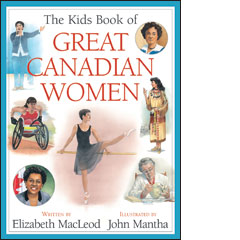 "I didn't know until I wrote Great Canadians that Elizabeth Arden is Canadian. Her original name was Florence Nightingale Graham, and her family had obviously decided early on what she would become. She didn't like nursing at all — the messiness of it or sick people — but she worked with burn victims and saw how lotions and things could help people and how important it was to feel good about your own appearance. I think that all that got her going in the directions she went, cosmetics, and now Elizabeth Arden is an internationally famous company. All from this small-town Ontarian who set out to have her own company."
"I didn't know until I wrote Great Canadians that Elizabeth Arden is Canadian. Her original name was Florence Nightingale Graham, and her family had obviously decided early on what she would become. She didn't like nursing at all — the messiness of it or sick people — but she worked with burn victims and saw how lotions and things could help people and how important it was to feel good about your own appearance. I think that all that got her going in the directions she went, cosmetics, and now Elizabeth Arden is an internationally famous company. All from this small-town Ontarian who set out to have her own company."
"Another story I love in the book is that of ThérPse Casgrain who was from Quebec and who was important in getting women the vote in there. In 1912, when she was about 16, she was in Paris with her family, and they were all set to sail home, but her father's business kept them late — and they missed their sailing on the _Titanic_. That's the kind of story that I have to keep looking and looking for, and when I find it, I'm so excited. That's why I keep researching. I know those stories are out there, and I want to include them in the book. Those are the stories that kids will remember and then maybe they'll get interested and read about ThérPse Casgrain and all of her amazing accomplishments. She was also the head of the Quebec Social Democratic Party (which later became the New Democratic Party), making her the first woman ever to lead a political party in Canada."
Asked to reflect on what effect being an editor of nonfiction has on her own writing, Liz says, 'I'm certainly aware of the impact of all those red marks when you get a manuscript back. My authors joke with me about this, but I make a real effort to say something positive on every single page because I'm asking them to correct and change so many things. Obviously those comments can be perceived as criticism, so I think it's important to give authors some positive feedback, too."
"As an editor, I also know what then goes into creating outline because I write them myself as an author. Consequently, I can help authors with that aspect so that we're not creating problems later on. I work hard with my authors on the outlines. I find that difficult because they don't have a contract at that point, so they're possibly working for nothing. But we're solving a lot of problems, and I'm hoping later on there will be no surprises and that the writing will then go fairly smoothly."
"As both an editor and author, I think I understand what my authors are going through because I go through it myself. I understand how difficult it is to choose what information to put in because I have to make those decisions, and so I talk things over with them. I understand more what my authors go through, and I think they appreciate that I have that extra knowledge."
Liz acknowledges that 'Editorial Liz' does look over her shoulder as she writes. "I know what's irritating to receive as an editor. For instance, I always clean up my manuscript before I send it into my editor because I hate getting a messy manuscript to edit. It's silly, but I go through and look for things such as double spaces. I clean up that sort of mistake, and I'm very aware of how my manuscript looks when it goes to the editor. I'm also very aware of length because, as an editor, I have to make sure that the text is going to fit on the page as it's supposed to fit."
"When I'm writing books in the 'Snapshots' series and thinking about what photos are going to appear on each spread, I'm thinking about how everything is finally going to look on the final page. I think I would be less aware of that if I wasn't an editor. I ask myself, 'How are these pictures going to look together?' and 'Have I got enough variety of images?' and that sort of thing, because the answers to those types of questions are going to have an impact on the final look of the spread and then of the book."
In describing her working habits, Liz says, "I find bills to pay are very good disciplinary tools! I'm at my desk at home every day, but I find it very easy to get distracted. I use the internet a lot for research, and boy, can you go off in a lot of directions! Cutting back on my editing to concentrate on writing is a new thing for me. I find it difficult to divide myself between editing and writing, especially if I want to try writing more picture books. I get too many balls in the air, and something gives. I'm going to try just writing for at least a year to see how it goes and discover if I can make enough of a living at it and if I enjoy it well enough."
"I like editing because I like working with authors. I also think it's good to see both sides as an author. As well, I'm a curious person, and so I like all the extra topics that I find out about with the books that I get to edit. I also enjoy the discipline, and this goes for the writing and editing, of having a limited number of words to say something. There's no room for filler and yet you still have to get a personality or some information across."
"I wish I were more disciplined. I'll do things such as stick in a load of laundry or something else that I wouldn't be doing if I worked in an office. I really enjoy the writing, and I don't mind working evenings on it. I guess writing, in addition to being a job, is a bit of a hobby for me. Working at your hobby isn't a luxury that most people have, so I don't mind doing it at night."
"I'm not an early bird, but I'm usually at my desk by about eight o'clock. I'll work until at least six, and I love being alone all day. I like having our cats around, but I work very well alone. I enjoy researching because, as I said, I am a very curious person. I think I'm lucky. Writing is a career that works for me. It works with my personality. It's not the most lucrative of careers, but I'm lucky my husband, Paul, values that it's something I like to do."
This article is based on an interview conducted in Toronto on February 26, 2005, and revised March, 2006.
